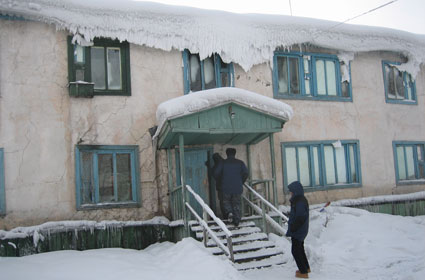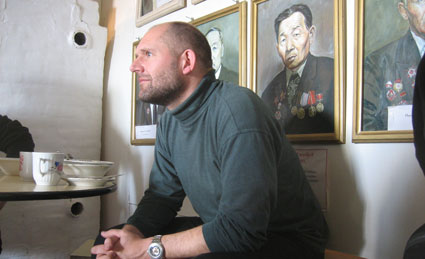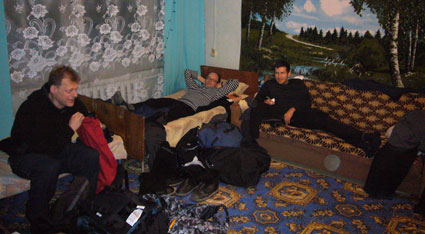Last night, the team met for dinner at Zürich's reastaurant Les Halles:

Hausi is the mastermind behind Sibiriak, which has organised this trek. Some people call him a churl*. In Russian this can be translated to muzhik, which is used in an honourable manner. Hausi has been organising trips to Sakha for many years. He is well connected and has a dense grid of logistic support in the area. This is my fourth trip with Hausi and I was never disappointed.

Chrigel is also a Sakha veteran. This will be our fourth trip together to this area. He was also part of the legendary MINUS72 team, who was reconnoitering this trek in 2003. This time, he was spared groping encounters by Siberian women. However, his thunderous laughter still sets them in a state of rapturous delight.

Gregor is again a veteran, however this is his first encounter in winter. He is a good sport, or as a German idiom says, someone to rustling horses together. Gregor is more of the calm and amicable type, which can be quite helpful in a group of prima donnas.

Markus is a German on his first trip to Russia. He came with his girlfriend to Les Halles. I did not much help that we could celebrate his birthday on this occasion, he was still the youngest member of the team. Markus' impressive wit and repartee and his apt to apprehend the rules of Jass made him the perfect companion despite his German origin.

My deriously beloved Toño was the only non engineer on the team. We reckon, that he will be the first Mexican on the Simnik (winter trail) through the Chersky Range. Unfortunately, he is still fighting with the aftermath of a inflammation of the middle ear and a serious cough. Not the best preconditions for the Northern Pole of Cold, but Toño is tougher than one might think.

And then there is me, Urs a.k.a gomad.ch. Urs means bear and there are many of them in Sakha. Maybe because of that, I'm going for the fifth time.
Not present at the dinner but essential for the success of the trip are Hausi's main local staff:

Vasily is the most careful driver of Sakha. He will steer his Vachtovka safely over the completely iced paths and trails of our route. Despite his extensive use of the Russian four-letter word хуй, he's the perfect gentleman.

Valentina will be our cook. Under the circumstances, her cuisine will be simple, nevertheless very delicious. Valentina can be stubborn as amuleox, which will add extra seasoning to the trip.

Azaliya is a pro-recto of the Yakut state university and Hausi's backbone of logistic in Yakutsk. In addition, Azaliya is a gifted chef and perfect host. It will be a pleasure to meet her again.
The first part of the trip was rather uneventful. An Airbus of Swiss brought us via Geneva to Moscow and then a Tupolev 145 of Domodedovo Airlines safely to Yakutsk.
* Coincidentally, the Medieval Latin form Carolus has the same roots as churl. The fame of Carolus Magnus, Charles the Great, or Charlemagne, added luster to the name Carolus and explains why the Slavic languages borrowed the name as their general word for "king", korol in Russian.

















 Our hotel
Our hotel



















